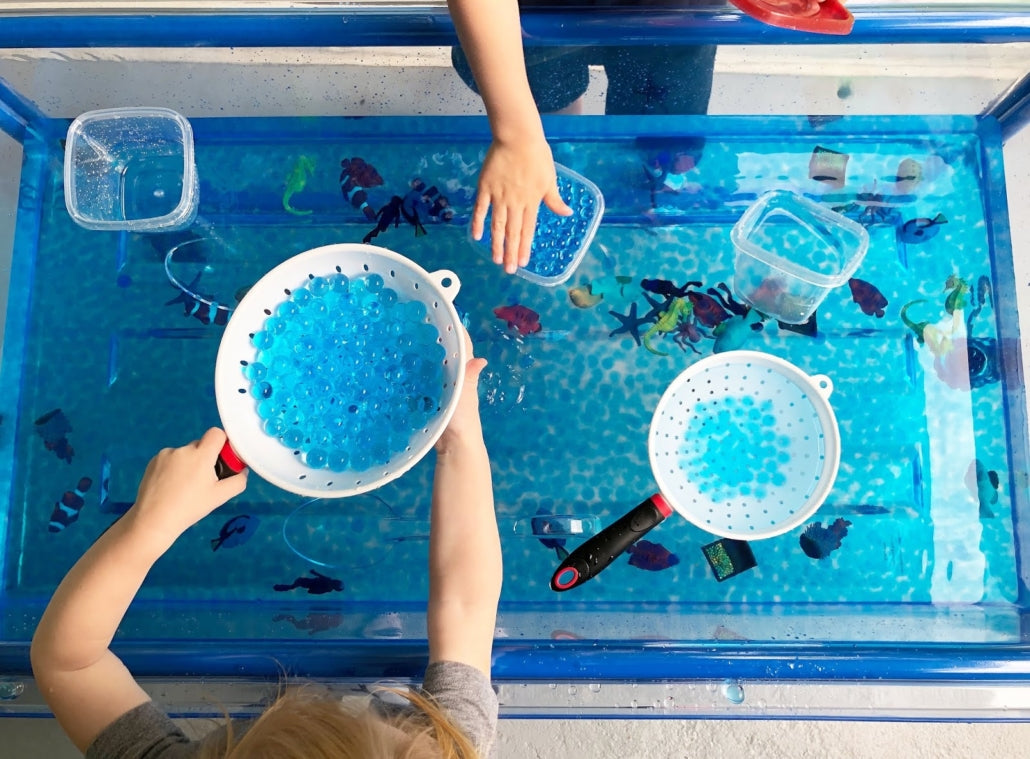
The Power of Play
Play is a child’s first language. It’s how they make sense of the world, build relationships, and develop crucial skills that will stay with them for life. When we create opportunities for unstructured, free play—whether at home or in the classroom—we give children the freedom to explore, experiment, and learn in a way that feels natural and exciting.
At Edx Education, we believe in the power of play-based learning and provide educational toys, resources, and inspiration through our Play, Learn & Create with Edx Education podcast. In this blog, we’ll explore how to set up play stations using simple yet effective resources like sand and water trays, sensory play trays, Linking Cubes, Pentominoes, and the 3D Stacking Puzzle. These stations encourage communication and language skills, social and emotional development, fine and gross motor skills, and problem-solving abilities.
Why Free Play Matters
While structured activities have their place, children need opportunities to lead their own play. Free play encourages:
- Creativity & Problem-Solving – Open-ended materials let children experiment, test ideas, and develop critical thinking.
- Social & Emotional Development – Playing with others fosters cooperation, turn-taking, and resilience.
- Communication & Language Skills – Talking, storytelling, and role-playing enrich vocabulary and comprehension.
- Fine & Gross Motor Skills – Manipulating small objects builds dexterity, while larger movements strengthen coordination.
With this in mind, let’s explore how to set up engaging play stations that support all these developmental areas.
1. Sensory Play with Sand and Water Trays
A sand and water tray is one of the most versatile play stations for early childhood development. It provides a multi-sensory experience, engaging sight, touch, and even hearing as children scoop, pour, and explore different textures.
Benefits:
- Encourages fine motor skills through scooping, pouring, and molding.
- Boosts language development as children describe textures and movements.
- Supports social skills through cooperative play.
- Helps with emotional regulation – the calming nature of water play can reduce anxiety.
How to Set It Up:
- Use sand, water, or a combination of both.
- Add tools like scoops, cups, sifters, and small figurines for added engagement.
- Introduce floating vs sinking experiments to encourage early STEM learning.
2. Building and Problem-Solving with Linking Cubes and Pentominoes
Linking Cubes and Pentominoes are fantastic for hands-on mathematical thinking and spatial awareness. These resources allow children to build, stack, and create, making abstract concepts more concrete.
Benefits:
- Strengthens fine motor skills as children connect and manipulate pieces.
- Encourages problem-solving and spatial reasoning.
- Supports language development as children describe shapes and structures.
- Builds collaboration skills when working in pairs or groups.
How to Set It Up:
- Offer a challenge—Can you build a bridge? A tall tower? A specific shape?
- Encourage storytelling—“Build a house for a tiny animal,” fostering creativity.
- Use Pentominoes for pattern recognition and early geometry.
3. 3D Stacking Puzzle for Coordination and Logical Thinking
The 3D Stacking Puzzle is an exciting open-ended toy that encourages children to explore balance, symmetry, and design.
Benefits:
- Develops fine motor control through precise stacking.
- Enhances hand-eye coordination and problem-solving skills.
- Encourages creative thinking—there is no one ‘right’ way to build!
- Supports resilience—children learn to rebuild if their structure topples.
How to Set It Up:
- Let children explore freely first, then introduce challenges like "Can you build a structure that stays balanced?"
- Combine with other materials like small figures or blocks to create a scene.
- Encourage discussions about shapes, stability, and symmetry.
Bringing It All Together
Play stations don’t have to be complicated or require expensive resources. A well-thought-out play space with open-ended toys can provide endless learning opportunities.
Tips for a Successful Play Station:
- Rotate materials to keep engagement high.
- Provide variety—mix sensory play, construction, and problem-solving activities.
- Follow the child’s lead—let them take ownership of their play.
- Join in Caregivers and educators can model curiosity and introduce new vocabulary.
At Edx Education, we champion play-based learning as the foundation for confident, curious learners. By setting up simple play stations at home or in the classroom, we can nurture children’s development in a natural, joyful way.
For more inspiration, explore our educational toys, free resources, and the Play, Learn & Create with Edx Education podcast.

